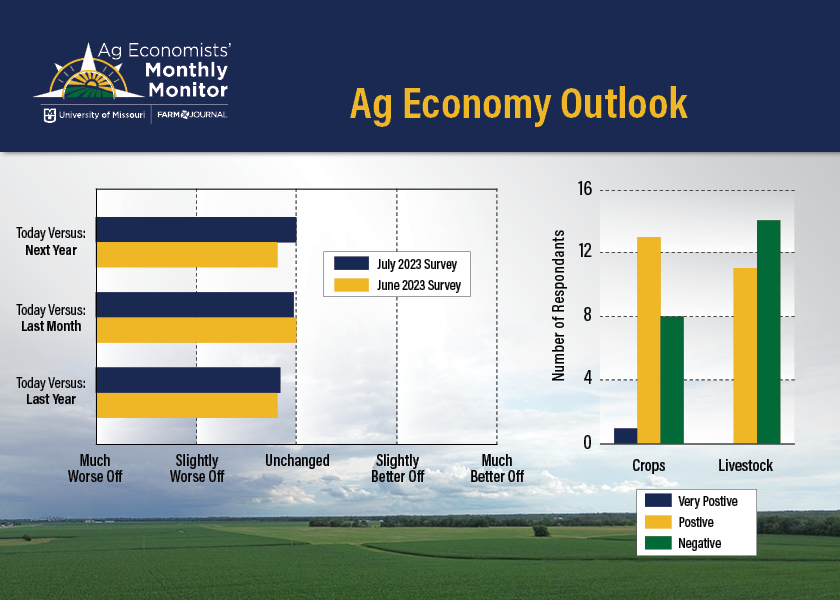Ag Economists Cast Doubt On Just How Much of a Reduction the U.S. Cattle Herd Has Seen in a Year

January’s cattle inventory report showed the smallest beef cow herd since 1962. As USDA prepares to release an updated look at beef cattle inventory this week, a survey of ag economists shows the possibility of only a small reduction year-over-year. If the forecast holds true, it could put a damper on forecasts for even higher cattle prices.
The July Ag Economists’ Monthly Monitor, which is a survey of nearly 60 ag economists from across the country, shows an average July 1 beef cattle inventory estimate of 30.1 million head. That’s slightly higher than what the same economists projected in June, which was 30 million head, but it’s not far from the 30.3 million head USDA reported last year.
“The Ag Economists’ Monthly Monitor for July pegs the beef cow herd at 99% of one year ago. That is a smaller decline in beef cow inventory than many of the pre-report estimates being discussed that are generally below 98% of a year ago,” says Scott Brown, a livestock economist with the University of Missouri and one of the authors of the Ag Economists’ Monthly Monitor. “The range of survey results is wide which may indicate the differences drought has played in different parts of the U.S.”
In January, USDA’s inventory report showed 28.9 million beef cows in the United States as of Jan. 1, 2023, down 4% from last year. The number of milk cows in the United States increased to 9.40 million.
If the results of the July Ag Economists’ Monthly Monitor are any indication of what USDA may reveal in its July report, Brown says it could have an impact on cattle prices.
“If the survey results are correct, it could spell lower prices in the months ahead relative to current expectations,” says Brown.

The July Ag Economists' Monthly Monitor also shows economists are more positive when asked about cattle and hog prices, but they have a more negative view on dairy, which they consider the biggest weight in the livestock sector.
“When you look at where pork prices have gone over the last month, it's gotten more positive. Now, I don't want to suggest we're back in black ink, but we have seen recovery in things like the pork cutout value,” Brown says. “The economists continue to worry about how the general economy will affect livestock going forward, but overall, it seems we're seeing a more positive view from the livestock perspective in this month's survey.”
The survey also shows economists think feed prices will be the biggest weight on livestock prices, but they do think USDA is too low on their average livestock price forecast for the year.
The average fed cattle price estimate in the July survey was $176 per hundred weight on fed cattle, 70 cents higher than USDA’s 2023 forecast. And economists think the average hog price will reach $59.90 per hundred weight this year, $2 above USDA’s current forecast.
What to Watch Over Next 6 Months
While most economists think cattle prices will continue to trend higher, they were also asked what factors they view as the biggest driver of livestock prices in the next six months. The responses varied in the July survey, but highlights include:
• “Domestic and international demand growth slowing.”
• “For fed cattle, continued good consumer beef demand will be most important. On the feeder side, corn prices will be the most important determinant of higher or lower prices even though they will remain well above a year ago.”
• “Placements of cattle on feed will be a major driving factor because it will determine the number of replacements being kept on pasture rather than being placed on feed. This has the potential to end the contraction phase of the cattle for 2024/2025 where cattle inventory may begin to grow again.”
• “The main factor affecting livestock prices will be macroeconomic factors influencing consumer demand for meat. Consumer sentiment and consumer spending appear to be weakening based on recent anecdotal evidence.”

Economists were also asked to share what they currently view as the most positive aspect of agriculture, including crops and livestock, one economist said, “Cattle markets are going to be extremely high in the coming year.” Another economist mentioned demand, saying, “The strength of U.S. meat exports is a real bright spot and is looking to continue to be positive going forward.”
Read the full results from the July Ag Economists' Monthly Monitor.







